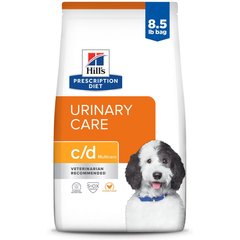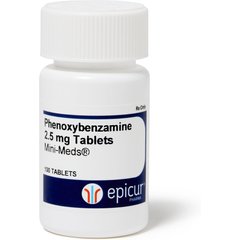Dog Not Peeing? Causes and When To Call Your Vet
Zheka-Boss/iStock / Getty Images Plus via Getty Images
If your dog can’t urinate (pee), he may have a urinary obstruction (blockage) and should be examined by a veterinarian right away.
This is a medical emergency.
Your dog’s urinary system is made up of the kidneys, which make the urine; the ureters, the tubes that move the urine from kidneys to bladder; and the bladder, which stores the urine and squeezes to get the urine out of the body through the urethra.
Health Tools
Not sure whether to see a vet?
Why Do Dogs Not Pee?
This condition affects both male and female dogs, and dogs that are unable to pee have an underlying issue.
When dogs cannot pee, there is typically either something affecting their ability to pee, blocking their ability to pee, or affecting the signaling pathway that causes them to pee.
Even though this condition is not as common in dogs as it is in cats, it’s still considered a medical (and possibly even surgical) emergency.
Signs Your Dog Can’t Pee
You might notice your dog acting strangely when urinating, making only little dribbles of pee, or straining to urinate without any urine coming out.
Your dog may also try to urinate multiple times, may whine when trying to pee, or may even lick or scratch at his genital region.
Over time, as your dog’s bladder becomes overly full of urine, he may:
Common Causes of a Dog Not Peeing
There are multiple causes of a dog not being able to urinate, such as:
-
Mechanical obstruction of the urethra by stones, cancer, or strictures (pathway getting smaller)
-
Neurologic disease such as lesions in the spinal cord or trauma to the spinal cord or brain
-
Detrusor atony (when the bladder muscle loses its ability to squeeze, and the bladder cannot empty correctly)
-
Anuria (true lack of urine production), often the result of kidney failure or injury
-
Urethral prolapse
-
Abdominal disease (constipation, cancer, intestinal torsion, organ enlargement), which causes pressure on the bladder
-
Phimosis in male dogs (inability to pull back the prepuce, the skin around the penis)
-
Trauma
-
Hernia with retroflexion of the bladder (bending of the bladder)
-
Blood clots or urethral plugs
-
Enlarged prostate or prostatic diseases including cancer
-
Bladder torsion (twisting)
-
Urinary tract infection (UTI)
Is a Dog Not Peeing an Emergency?
Yes—it's an emergency. If your dog can't urinate, take him to the emergency vet immediately.
When your dog cannot pee, the waste products in the urine stay in the body and toxins can build up in the bloodstream, causing whole body effects and organ damage.
Also, the bladder will continue to fill up with urine, causing discomfort and pain. Over time, this can affect the bladder muscle, which can further lead to an inability to urinate.
How Veterinarians Diagnose Causes of a Dog Not Peeing
If your dog is not peeing, your veterinarian will do a thorough physical examination, where they’ll check your dog’s urinary tract and genitalia for physical signs of disease or pain.
Additionally, your vet may:
-
Palpate (feel) the abdomen to try and figure out if the bladder is distended (enlarged) and painful.
-
Perform a rectal exam to palpate the distal urethra and prostate in male dogs, feeling for any masses, stones, or enlargement. A neurologic exam will be done to check mentation (mental activity), reflexes, and spinal pain or discomfort.
-
Do blood work to figure out the extent of the obstruction, because electrolyte disturbances and kidney values can be affected and may need immediate medical help before any more testing.
-
Recommend a urinalysis to check your dog’s urine. The sample may even be sent to a reference laboratory as a culture and sensitivity looking for evidence of infection.
-
Perform imaging such as X-rays or ultrasound or even cystoscopy (visualization of the urinary tract through a scoping procedure) to rule out stones, cancer, or other causes of obstruction.
In advanced or complicated cases, the veterinarian may refer your dog to a specialist for additional diagnostics such as the cystoscopy or CT/MRI.
Treatment For a Dog That Can’t Pee
Treatment of your dog’s inability to urinate may vary.
Treatment depends on the underlying cause.
Before figuring out a diagnosis, to provide immediate relief and prevent further life-threatening risks, your veterinarian may recommend either a therapeutic cystocentesis (where the urine from the bladder is removed via needle and syringe) or the passage of a urinary catheter, which may need sedation or anesthesia to put in.
To give time for the other treatments to work—and to allow for the pain and inflammation to go down—the urinary catheter may be kept in place for several hours to several days depending on the cause.
Other therapies beyond those related to specific causes may include:
-
Antibiotics
-
Lifelong dietary changes such as prescription Royal Canin® urinary s/o or renal; Hill’s® c/d, s/d, or k/d; or Purina® NF or UR
-
Treating a urethral obstruction requires a urinary catheter and flushing of the blockage (if possible) back into the bladder to be surgically removed.
-
Alternatively, a urethrotomy (directly cutting into the urethra) or a urethrostomy (creating a new urethral external opening) may be done.
-
Bladder stones, polyps, and some cancers can be surgically removed.
-
Bladder cancer can also be treated with chemotherapy or radiation.
-
Urinary tract infections and crystalluria (crystals in the urine) may be treated with antibiotics and dietary changes.
Dogs with neurologic complications or other conditions listed above may be helped by certain medications like bethanechol, oxybutynin, phenoxybenzamine, or prazosin.
Some dogs may need lifelong manual expression of the bladder (have a pet parent put pressure on the bladder to empty it).
If this is needed, your veterinarian will instruct you on how and when to correctly express your dog’s bladder.
Unfortunately, if the prognosis is poor or there are life-altering complications, humane euthanasia may be recommended.




